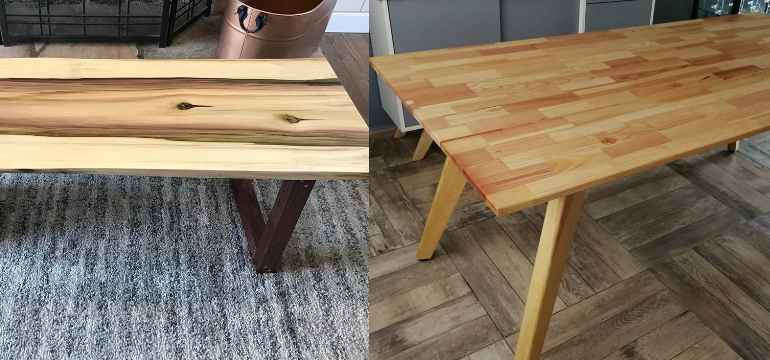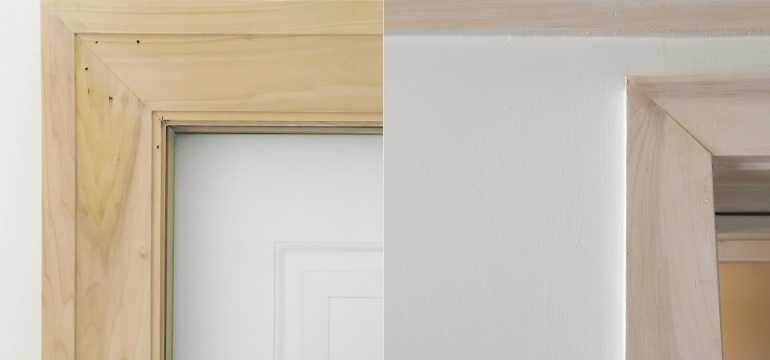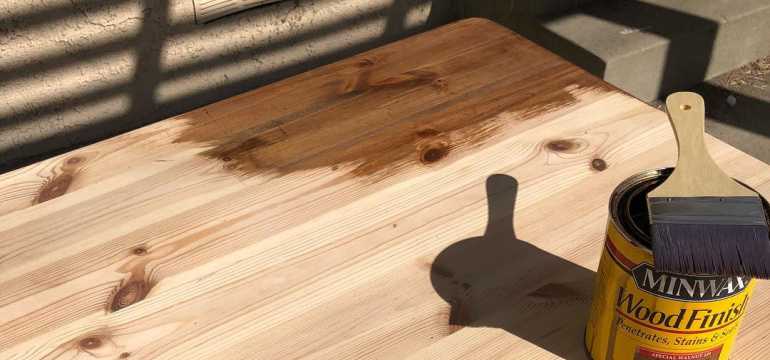Is Pine Easy to Paint Than Poplar
Are you new to doing your own woodworking projects? Curious about the difference between various types of wood? As you begin working with wood, you will likely notice that two of the cheaper, softer, commonly used woods are poplar and pine. But which one is better to work with? In this guide, we'll talk poplar vs. pine and go through some pros and cons for both, specifically with regards to hardness, price, and use.
Is Poplar Harder than Pine?
 Well, it all depends on the type of pine you are talking about. While poplar and yellow poplar have essentially the same hardness, but there are many different types of pine, and they vary widely in terms of hardness.
Well, it all depends on the type of pine you are talking about. While poplar and yellow poplar have essentially the same hardness, but there are many different types of pine, and they vary widely in terms of hardness.
Hardwood Vs. Softwood
Hardwoods are deciduous trees, which means that they shed all their leaves once a year, prior to the cold season. Softwoods are evergreen, meaning that they keep all their leaves even during the coldest of times. However, the terms hardwood and softwood don't necessarily dictate whether a tree's lumber is comparatively soft or hard in terms of density. For example, poplar is technically a hardwood, but it is softer than some kinds of pine, which is a softwood. Confused? We'll break it down for you.
Hardness Scale
When it comes to trees, hardness is referred to in terms of pound-feet, or lb-ft, or lbf, as it is often abbreviated. The scale being used is the Janka scale, developed by Gabriel Janka. For the standard poplar or yellow poplar tree, the lumber's average hardness is typically 540 lb-ft. By contrast, the Eastern white pine is rated at 380 lbf, which is significantly lower or softer.
Western white pine gains a bit on the hardness scale, coming in at 420 lbf, but that is still a lot less than poplar. The radiata pine, however, is significantly harder, with a rating of 710 lbf, and the Southern yellow pine (longleaf variety) is even better at a super-hard 870 lbf. The Caribbean Heart Pine is close to first place, at 1280 lbf. But the pine with peak hardness is the True Pine (Timborana), with a stunning score of 1570 lbf.
Curious about the tree that ranks highest of all the trees, not just the pines? It's the Australian Buloke, at 5,060 lbf.
So if you're curious about comparative hardness, you first need to determine the type of pine you're talking about.
Poplar vs. Pine: Furniture
 Are you planning to build a piece of furniture, such as a desk, chair, table, bookcase, or dresser? Either poplar or pine will work, but they each have their own advantages. Keep in mind, as we mentioned before, that there are many varieties of pine. For the purposes of this guide, we'll focus on the two most common kinds, which are regular white pine and yellow pine.
Are you planning to build a piece of furniture, such as a desk, chair, table, bookcase, or dresser? Either poplar or pine will work, but they each have their own advantages. Keep in mind, as we mentioned before, that there are many varieties of pine. For the purposes of this guide, we'll focus on the two most common kinds, which are regular white pine and yellow pine.
So if you're leaning towards making pine furniture, you'll be shopping for yellow or white pine lumber. Though they may not be the strongest types of pine, they are fairly easy to work with, and they yield a sturdy, attractive result. Be aware that some kinds of pine will tend to splinter and crack when they are dry, while other types of pine, such as the Southern yellow pine, tend to have a lot of sap.
Pine is tough and shock-resistant. However, it may be a tad more susceptible to temperature changes and effects, so be aware that it isn't really the best choice for furniture that you plan to use outdoors. You'll usually see pine used for rustic furniture, like that found in a mountain cabin, a beach house, or a farmhouse. Pine has an attractive rich color, ranging from yellow-gold to amber or red-brown. Part of the final color shade will depend on the type of stain and shellac that you use.
Poplar doesn't dent as easily as pine does. It is a light to medium weight hardwood, which means that it blends durability with mobility. It's much lighter than pine, so furniture made from poplar will be easier to move around if you decide to rearrange your home. Although pine is sturdy and heavy, it's not as heavy as oak.
Poplar vs. Pine: Trim
 Trim is an important part of the finished look of your home. The term can refer to any number of pieces, from door and window casings, to cap molding and back band, to chair rail and wall paneling. Trim also includes baseboards and crown molding.
Trim is an important part of the finished look of your home. The term can refer to any number of pieces, from door and window casings, to cap molding and back band, to chair rail and wall paneling. Trim also includes baseboards and crown molding.
If you're thinking about poplar vs. pine trim for your home, that's a completely different story than if you are debating poplar vs. pine for furniture. Trim is thinner than furniture and requires more machining to get it just right visually. That's why we would recommend using poplar or another wood, rather than pine. Poplar may be a bit blotchy to stain, as we will discuss in the next section, but it is much easier to machine, especially if you're looking for a nice crisp finish. Because of its soft nature, poplar may give you slightly more blurred edges than another type of hardwood, but it's still better than pine.
Some types of harder pine can make beautiful trim, include lovely crown molding. Keep in mind that because of its broad grain and frequent knots, pine trim is usually meant to be painted, not stained. Even poplar, with its straighter and narrower grain, is typically painted when it is used as molding or trim.
If you're set on having stained pine trim, keep in mind that its final look is going to be a bit blockier and more rustic. If that's the aesthetic you want, go for it. Window casings and door trim can look quite charming when they're done with stained pine finished with shellac, as long as you're okay with that cozy cabin look.
Remember to keep the trim of a space in scale with the size and shape of the room. A house with small rooms and lower ceilings will look more crowded and small if you use large, wide trim pieces in a darker color. If you're not sure about how to scale the trim correctly to the various spaces in your home, consider hiring a designer to help you out, since the finishes are so important to the final look of your home.
Poplar vs. Pine: Staining
 Poplar is a fairly soft, porous wood. And when we're talking about the white pine and yellow pine most commonly used for furniture, they are also fairly softwoods. Because of their softer nature, porosity, and grain texture, both pine and poplar tend to be very blotchy when you stain them. The best way to avoid that ugly blotchiness is to pre-condition the wood.
Poplar is a fairly soft, porous wood. And when we're talking about the white pine and yellow pine most commonly used for furniture, they are also fairly softwoods. Because of their softer nature, porosity, and grain texture, both pine and poplar tend to be very blotchy when you stain them. The best way to avoid that ugly blotchiness is to pre-condition the wood.
Some experts recommend using a Minwax pre-stain conditioner and following that up with stain. You can also finish off the furniture you're building with a nice coat of polyurethane. This serves as a final seal, securing the wood against spills, moisture, and damage. It also provides a delightful glossy lacquered look which many users enjoy. If you're DIYing the furniture, definitely consider adding a coat of poly to get a professional look.
Sealing is especially important with pine. Pinewood, especially the white and yellow varieties typically used for furniture, tends to have knots. These knots can eventually leak some sap, and if they are not sealed, that can be awkward and sticky. Make sure to use poly or shellac for that.
Poplar Vs. Pine: Cost
Now let's talk about cost. Again, this is a very general overview. The prices for certain types of wood, especially pine, will vary depending on the type of pine lumber you plan to use. Another factor for the cost is whether or not that type of wood is native to your area. If it has to be shipped in from another section of the country, chances are it will be more expensive.
Pine is cheaper than several other types of wood, including oak. It is commonly considered the cheapest wood used in furniture. In many cases, it's even cheaper than poplar. Poplar tends to be somewhat easier to work with since it's lighter and has fewer knots and less sap. As we have said, poplar machines better than pine.
Since it doesn't have any knots, you'll be able to sand, treat, and finish or paint it to look like a more expensive wood, whereas pine is pretty much discernible by the knots and chunky texture no matter what you do to it. All that to say—pine is typically cheaper, but in some cases, you may want to throw down the extra cash and choose poplar. The finer and more detailed the project, the harder and more expensive the wood you will need for it.
Sourcing Your Lumber
Some additional considerations involve the sourcing of the wood. In some cases, if you're looking for a rarer type of pine, you may be out of luck. The old-growth longleaf pine, or heart pine, is no longer available due to over-harvesting, so if you are interested in that type of wood, you will need to find a second-hand source. Sometimes you can obtain some of this beautiful, magnificent wood from older buildings that are being taken down or remodeled. In previous decades, heart pine was sometimes used for the beams or floor joists in such buildings.
As you look for places to purchase your pine or poplar, consider where the seller is getting their lumber. Are they working with companies that are careful about over-harvesting? Are they environmentally conscious, focused on planting new trees, and preserving habitats? While the lumber from such companies might be a bit more expensive, it's well worth it to support the health of the planet, its forests, and its creatures.
Source: https://www.h2ouse.org/poplar-vs-pine/
0 Response to "Is Pine Easy to Paint Than Poplar"
Post a Comment